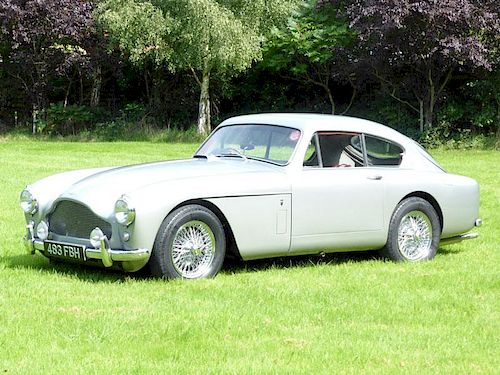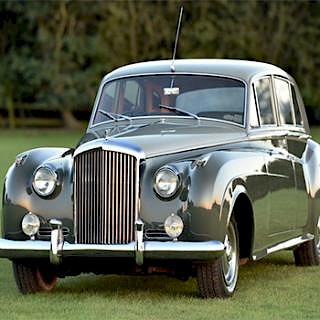The elegant DB2 was a major step forward from the 2-Litre Sports model it replaced. The newcomer was
Estimate:
$333,441 - $363,754
Absentee vs Live bid
Two ways to bid:
- Leave a max absentee bid and the platform will bid on your behalf up to your maximum bid during the live auction.
- Bid live during the auction and your bids will be submitted real-time to the auctioneer.
Bid Increments
| Price | Bid Increment |
|---|---|
| $0 | $10 |
| $100 | $25 |
| $500 | $50 |
| $1,000 | $100 |
| $3,000 | $250 |
| $5,000 | $500 |
| $10,000 | $1,000 |
| $30,000 | $2,500 |
| $50,000 | $5,000 |
| $100,000 | $10,000 |
About Auction
By H&H Classics Limited
Oct 14, 2015 - Oct 15, 2015
Set Reminder
2015-10-14 07:00:00
2015-10-15 07:00:00
America/New_York
Bidsquare
Bidsquare : The Imperial War Museum Motor Car Auction
https://www.bidsquare.com/auctions/h-h/the-imperial-war-museum-motor-car-auction-958
H&H Classics Limited info@handh.co.uk
H&H Classics Limited info@handh.co.uk
- Lot Description
BID ON THE-SALEROOM.COM
The elegant DB2 was a major step forward from the 2-Litre Sports model it replaced. The newcomer was based on a modified version of the square tube chassis originally designed by Claude Hill for the Atom prototype. It was clothed in a flowing all-alloy body penned by Frank Feeley and powered by the 2.6-litre straight-six Lagonda engine conceived by W.O. Bentley and Willie Watson. Yes, this was a car with pedigree, something that was emphatically confirmed a few months later with a first and second in class finish at Le Mans.
Production of the DB2 continued until 1953 when it was replaced by the DB2/4. A logical progression, the DB2/4 featured a pair of occasional rear seats and an eminently practical hatchback tail. Other notable changes included a wraparound windscreen, larger bumpers and repositioned headlights. By the middle of the following year the engine had grown in capacity to 2.9-litres, increasing the power output to 140bhp and the top speed to 120mph. It was in 1954 that David Brown acquired the Tickford Coachbuilding Works at Newport Pagnell, and it was there rather than Feltham the MKII versions of the DB2/4 were made from 1955. The revised model featured small tailfins, bubble-type tail lights and added chrome. There was the option of a large-valve, high compression engine of 165bhp output and two different body styles - a 2+2 Hatchback and two-seat Drophead Coupe.
The final iteration of the DB2/4 was launched at the 1957 Geneva Salon. Somewhat confusingly christened the DB Mark III, it featured disc front brakes (from the first 100 cars onward) and Alfin drums on the rear, a hydraulic clutch, plus the options of overdrive for the standard manual gearbox and automatic transmission. The obvious visual differences were the adoption of a DB3S-style radiator grille and sensuously sculptured bonnet. The rear lamps were changed once more and the rear quarter lights made to open. Inside, an all-new instrument panel greeted the driver. The engine, which had been heavily reworked by Tadek Marek, featured a new crankshaft, stiffer crankcase, and induction modifications inspired by the racing unit of the DB3S. The power of the standard version was now up to 162bhp, while those equipped with the optional dual exhaust system were claimed to produce 178bhp - enough to sprint the Aston to 60mph in 9.3 seconds. There was now the choice of three body styles - 2+2 Hatchback, Drophead Coupe and Fixed Head Coupe; though the latter only accounted for five of the 551 Mark IIIs built between 1957 and 1959.
By the time Goldfinger reached the silver screen, 007 was behind the wheel of a gadget-equipped DB5, but in the Ian Fleming novel from which the film was derived, he piloted a gadget-modified DB Mark III - erroneously referred to as a DB III throughout the book.
This delightful DB MKIII hails from 1958 and is finished in Silver with contrasting Burgundy-coloured hide and matching Wilton carpets. It is equipped with overdrive, DB4 GT front brake calipers and braided brake lines. The Aston has just been treated to a complete engine overhaul during which one of the new and improved Vetus cylinder blocks was installed. The vendor informs us that the car has also been continuously well maintained, courtesy of regular visits to Four Ashes Garage in Stratford-upon-Avon. Its comprehensive history file contains invoices totalling in excess of £75,000 in the last five years, £20,000 of which is from 2015, as well as previous FIA papers - suggesting earlier competition activity. The vendor has no hesitation in classing the bodywork, paintwork, interior trim, engine and transmission as all being in 'excellent' order and considers '483 FBH' to be 'eminently collectable'. - Shipping Info
-
Shipping info
-
- Buyer's Premium



 EUR
EUR CAD
CAD AUD
AUD GBP
GBP MXN
MXN HKD
HKD CNY
CNY MYR
MYR SEK
SEK SGD
SGD CHF
CHF THB
THB









